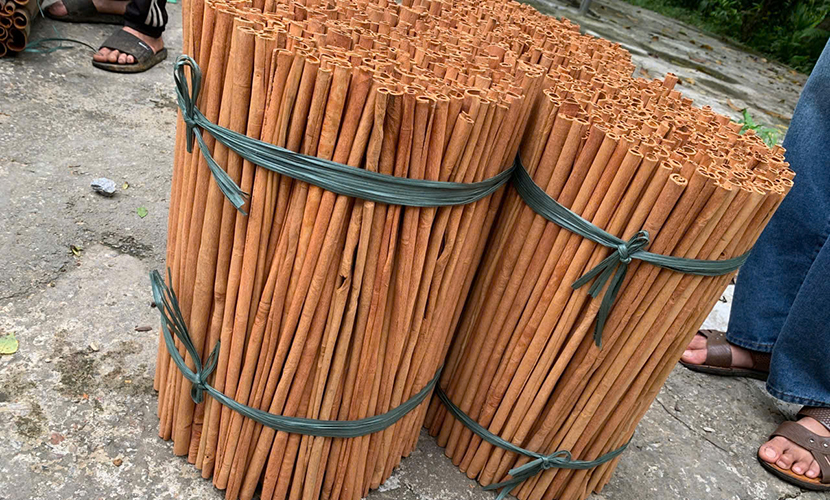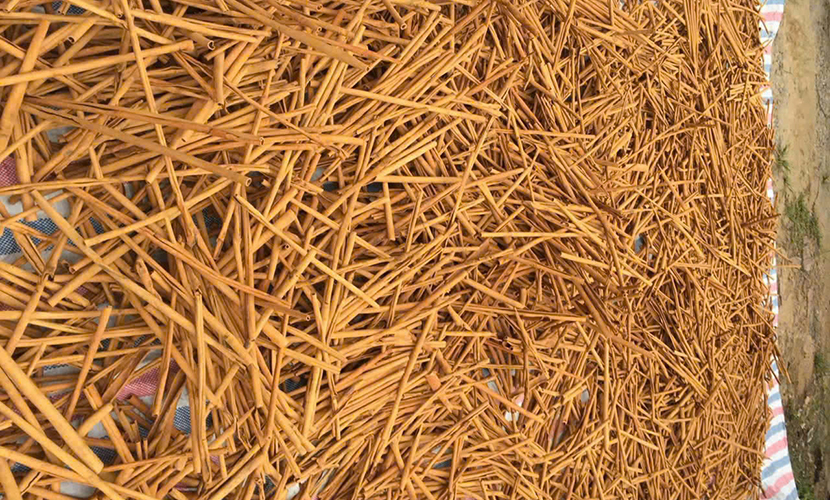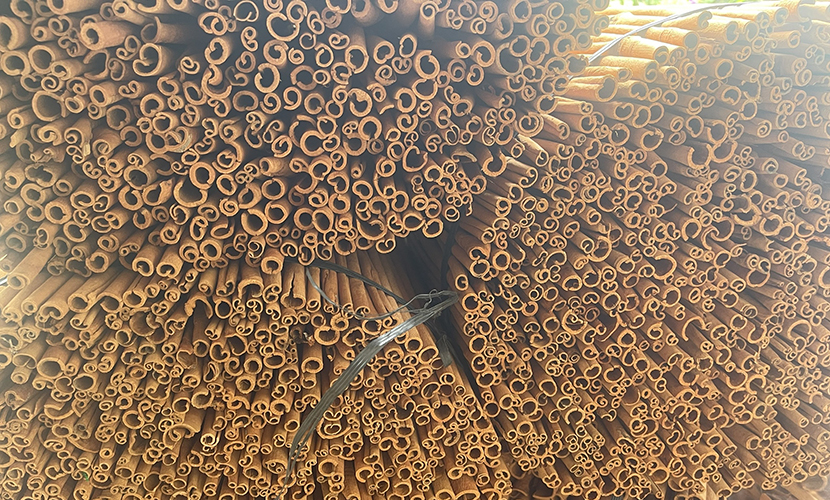Vietnamese cinnamon sticks is one of the ten key crops of Yên Bái province. Specifically, they account for up to one-third of the province’s planted forest area. With a raw material area of over 81,000 hectares, Vietnam’s cinnamon in recent years has become an important crop. Therefore, it helps reduce poverty and increase the wealth of farmers in many localities.
Đào Thịnh is a commune of Trấn Yên district, Yên Bái Province. Local people used to mainly rely on growing rice, corn, and mulberry trees. In recent years, more than 800 hectares of Vietnamese cinnamon have contributed to poverty reduction. As a result, they have also increased the prosperity of the local residents.
Nguyễn Trí Tuệ’s family, from Hamlet 5, is among the pioneering households to cultivate cinnamon in Đào Thịnh commune. After leaving the military, he had the simple idea of creating jobs. In 1993, he boldly leased forest land to plant over 2,000 cinnamon trees.

Vietnamese cinnamon sticks
During the first nearly ten years of implementing the Vietnamese cinnamon cultivation model, Tuệ faced many difficulties. These ranged from technical challenges to market issues. There were many times when prices of Vietnamese cinnamon sticks fell low, but he persevered to become prosperous from cinnamon.
While working and gradually expanding his area, Tuệ has grown his cinnamon business. Today, his family owns about 20 hectares of cinnamon, generating an annual income of over 300 million VND.
“Currently, our family has boldly applied organic planting and care methods, which has helped expand the market. Especially with the support of the cooperative, the economic efficiency has become more stable and higher,” Tuệ said enthusiastically.
In recent years, local people in the commune have aimed to increase production value. Therefore, they have implemented clean and organic cinnamon production processes.
Đào Thịnh Cassia Cooperative will purchase Vietnamese cinnamon sticks from Đào Thịnh commune and surrounding areas. The cooperative pays prices 2,000–5,000 VND/kg higher than the market rate. The cooperative now has 20 joint-member partners. Also, it collaborates with hundreds of local households to develop a raw material area of over 700 hectares.

Vietnamese cinnamon forest
On average, the cooperative purchases around 100 tons of fresh cinnamon each month. It processes cinnamon into 12 types of Vietnamese cinnamon products. They include cinnamon powder, cinnamon sticks, split cinnamon, and cinnamon essential oil.
Additionally, the cooperative has established an organic cinnamon processing factory with a capacity of over 100 tons per month. All Vietnamese cinnamon sticks meet quality standards from the demanding markets such as the US, EU, and Japan.
Another success story in cinnamon cultivation is the Vietnam Cassia Cooperative, established in 2017. Currently, the cooperative is implementing a production and export project with a total investment of over 80 billion VND. The project focuses on developing organic cinnamon areas certified to international standards.
Thanks to stable operations and a wide consumer market, the cooperative provides regular employment for 50–100 workers. Its annual revenue averages over 30 billion VND, purchasing Vietnamese cinnamon sticks from Đào Thịnh and neighboring communes.
A representative of the cooperative stated that when it was first established, it had only 1.5 hectares of organic cinnamon. Today, after linking with households that cultivate cinnamon according to proper procedures, the area has expanded to 500 hectares.

Vietnamese cinnamon harvesting
After harvesting, workers will sort and process cinnamon materials into twelve types of products. They include split cinnamon, cinnamon sticks, cinnamon powder, and cinnamon essential oil. These products are available to India, Middle Eastern countries, South Korea, the United States…
Along with essential oil, dried cinnamon bark is material to process into cinnamon sticks, round cut cinnamon, split cinnamon. Cinnamon powder is an ingredient for tea, as a food spice, or in medicinal products. Cinnamon wood is a durable building material for building houses and making household furniture, floorboards, veneer, and planks.
In addition, handcrafted products from cinnamon bark, essential oil, and wood are diverse and abundant. There are over 20 types, including gift boxes, scented bags, car air fresheners, toothpick holders, flower vases, tea containers, night lamps, cinnamon paintings, teapots and cups, and rolled cinnamon sticks.
Mr. Dang Cong Long is the Director of the Van Yen Cinnamon Cooperative. He said that for handcrafted cinnamon products, the cooperative has invested significant effort in research, experimentation, and development. Under the skillful and meticulous hands of artisans, these efforts have produced unique and practical products. They have helped establish a recognized brand both domestically and internationally.

Drying Vietnamese cinnamon sticks
“The cooperative is also very proud that handcrafted cinnamon products have been selected by the provincial and district authorities as souvenirs. These souvenirs represent Yên Bái province in general and Van Yen district in particular, and are likely to introduce the region to friends at home and abroad,” Long said.
It is clear that organic cinnamon production is a development path that has aligned with current trends. It contributes to higher economic value and helps establish the Yên Bái cinnamon brand globally.
Recent analyses show that over the next ten years, the global organic spice market will grow by at least 4.6% annually. It is likely to reach a total value of $15 billion.
Specifically, the cinnamon market is likely to grow on average 14% per year through 2025. This presents a significant opportunity for Yên Bái in particular and Vietnam in general, as cinnamon is a highly favorable spice in many countries.
However, of the 150,000 hectares of Vietnamese cinnamon sticks grown nationwide, only a small portion is certified organic. Therefore, representatives of the Vietnam Trade Office in Canada—one of Vietnam’s main export markets for cinnamon—believe that further investment is neccessary in quality, processing, and market expansion. They emphasize that this is more important than focusing solely on raw exports, as is currently the case.

Cinnamon sticks from Vietnam
Experts suggest that the Vietnam Cassia Association should develop a geographic indication strategy for Vietnamese cassia cinnamon. This strategy would help promote and emphasize its advantages over Ceylon cinnamon from South Asia.
Additionally, businesses should collaborate with other sectors to enhance the value of deep processing. They should also introduce new products to the market, such as cinnamon blossom honey and cinnamon-scented candles.
Furthermore, for sustainable cinnamon development, each link in the chain—farmers, cooperatives, businesses, and regulatory agencies—needs to consciously raise awareness and responsibility. This collective effort is essential to protect the value, rights, and brand of Yên Bái cinnamon.
At the same time, strengthening coordination among the “four stakeholders” ensures mutual accountability and oversight. This collaboration helps jointly maintain the sustainable development of Yên Bái cinnamon in the future.
Vietnamese source: https://vnbusiness.vn/mo-hinh/trong-que-ban-khap-the-gioi-nong-dan-yen-bai-ngay-cang-giau-len-1099394.html






